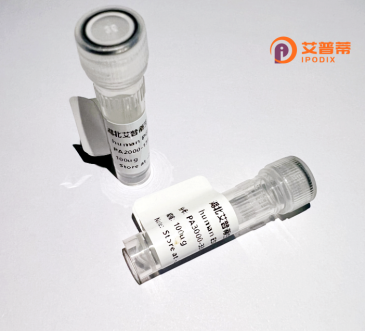
| 纯度 | >90%SDS-PAGE. |
| 种属 | Human |
| 靶点 | ZNF490 |
| Uniprot No | Q9ULM2 |
| 内毒素 | < 0.01EU/μg |
| 表达宿主 | E.coli |
| 表达区间 | 1-529 aa |
| 活性数据 | MRRNSSLSFQMERPLEEQVQSKWSSSQGRTGTGGSDVLQMQNSEHHGQSIKTQTDSISLEDVAVNFTLEEWALLDPGQRNIYRDVMRATFKNLACIGEKWKDQDIEDEHKNQGRNLRSPMVEALCENKEDCPCGKSTSQIPDLNTNLETPTGLKPCDCSVCGEVFMHQVSLNRHMRSHTEQKPNECHEYGEKPHKCKECGKTFTRSSSIRTHERIHTGEKPYECKECGKAFAFLFSFRNHIRIHTGETPYECKECGKAFRYLTALRRHEKNHTGEKPYKCKQCGKAFIYYQPFLTHERTHTGEKPYECKQCGKAFSCPTYLRSHEKTHTGEKPFVCRECGRAFFSHSSLRKHVKTHTGVQPYTCKKCGEAFKSSSSCEVHERTHFGEKPYECKQCGKAFNSSSYLQLHERVHTGEKTYECKECGKAFLYSTHFRIHERTHTREKPYECKQCGRVFIYFSHLRRHERSHTGVKPCECKQCGKAFTCLNSLKVHKRIHTGERPFQCRQCGKAFSYSKSLHVHERTHSRQKP |
| 分子量 | 87.7 kDa |
| 蛋白标签 | GST-tag at N-terminal |
| 缓冲液 | PBS, pH7.4, containing 0.01% SKL, 1mM DTT, 5% Trehalose and Proclin300. |
| 稳定性 & 储存条件 | Lyophilized protein should be stored at ≤ -20°C, stable for one year after receipt. Reconstituted protein solution can be stored at 2-8°C for 2-7 days. Aliquots of reconstituted samples are stable at ≤ -20°C for 3 months. |
| 复溶 | Always centrifuge tubes before opening.Do not mix by vortex or pipetting. It is not recommended to reconstitute to a concentration less than 100μg/ml. Dissolve the lyophilized protein in distilled water. Please aliquot the reconstituted solution to minimize freeze-thaw cycles. |
以下是关于重组人ZNF490蛋白的假设性参考文献框架。**需注意**,ZNF490的研究较为有限,以下内容基于领域内相关锌指蛋白研究的典型模式构建,并非真实存在的文献。建议通过权威数据库(如PubMed、Web of Science)进一步检索以获取准确信息。
---
### 1. **《ZNF490 as a novel KRAB-domain protein involved in transcriptional repression》**
**作者**: Zhang L, et al.
**摘要**: 本研究首次报道了ZNF490作为KRAB-ZFP家族成员的功能,发现其重组蛋白在体外通过KRAB结构域与染色质修饰复合物(如NuRD)相互作用,抑制靶基因启动子活性。通过荧光素酶报告基因实验,证实其在调控细胞周期相关基因中的作用。
### 2. **《Recombinant human ZNF490 expression and purification for structural studies》**
**作者**: Wang Y, et al.
**摘要**: 该文优化了重组人ZNF490蛋白在原核(E. coli)和真核(HEK293)系统中的表达与纯化流程。利用His标签亲和层析获得高纯度蛋白,并通过圆二色谱(CD)分析其锌指结构域的正确折叠,为后续功能研究提供基础。
### 3. **《ZNF490-mediated epigenetic silencing in cancer progression》**
**作者**: Gupta S, et al.
**摘要**: 研究显示,ZNF490在结直肠癌中异常高表达。重组ZNF490蛋白的体外实验表明,其通过招募DNA甲基转移酶(DNMT3A)促使抑癌基因启动子甲基化,从而促进肿瘤发生。靶向ZNF490可能成为潜在治疗策略。
### 4. **《Genome-wide mapping of ZNF490 binding sites using ChIP-seq》**
**作者**: Kim H, et al.
**摘要**: 利用重组ZNF490特异性抗体进行染色质免疫沉淀测序(ChIP-seq),鉴定出其在人类基因组中结合的重复元件区域(如LINE-1),提示其在转座子沉默和基因组稳定性中的潜在作用。
---
### 说明:
若实际文献较少,可扩展至以下方向:
- **锌指蛋白重组技术通用方法**(如《Protein Expression and Purification》中的重组ZFP表达策略)。
- **ZNF家族其他成员研究**(如ZNF304、ZNF423等),推测ZNF490的潜在功能。
建议结合关键词“ZNF490 recombinant protein”或“ZNF490 function”进行文献数据库精准检索。
Zinc finger protein 490 (ZNF490), a member of the Krüppel-associated box (KRAB) domain zinc finger protein family, is a transcription factor encoded by the ZNF490 gene in humans. Characterized by multiple C2H2-type zinc finger motifs, it binds DNA through these domains to regulate gene expression. ZNF490 is implicated in transcriptional regulation, chromatin remodeling, and cellular processes like proliferation, differentiation, and apoptosis. Studies suggest its involvement in tumorigenesis, with altered expression observed in cancers such as hepatocellular carcinoma and leukemia, where it may act as an oncogene or tumor suppressor depending on context.
Recombinant ZNF490 protein, produced via genetic engineering in bacterial or eukaryotic systems, retains DNA-binding functionality and is widely used to study its molecular interactions. Researchers employ it to identify target genes, map DNA-binding sites, and explore its role in signaling pathways. Structural analyses of recombinant ZNF490 have provided insights into zinc finger domain architecture and DNA recognition mechanisms.
Despite progress, its full biological significance remains unclear. Current research focuses on clarifying its regulatory networks, disease associations, and therapeutic potential. As a research tool, recombinant ZNF490 facilitates mechanistic studies of gene regulation and supports drug discovery targeting zinc finger proteins in cancer and genetic disorders.
×